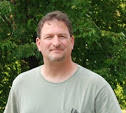Friday, April 30th (6PM). I came home from work and tried to talk Char into accompanying me up to Big Meadow, a campground located along Skyline Drive while I did some astrophotography in a relatively dark-sky site. She looked at me like I was crazy and told me to have fun and write when I find work. :o)
Skyline Drive follows the Appalacian Mtns. in Virginia and is about 40 minutes from our house. Big Meadow is 30 minutes down the Skyline.
I loaded up the SUV with all my telescope and camera gear and proceeded to Big Meadow. An hour and fifteen minutes later I arrived just as twilight gave way to dark. I set-up my scope and other accessories while a herd of deer watched curiously from a distance.
The reason I was so intent on observing and photographing from the Skyline is because The Omega Centauri Star Cluster (NGC 5139) is visible in the northern hemisphere for two weeks this time of year. NGC 5139 was not due up until midnight so I photographed galaxies M51, M101 the Moon and star cluster M13 to pass the time.
I could not believe how dark it was up here compared to light polluted Northern Virginia. I thought: "What a great idea to come up here and experience nature at its finest". Just then, a coyote howled in the distance and I could hear (but not see) a couple of animals hauling tail away from the coyote.
Then I though: "What a bad idea coming up here without a weapon, other than my aluminum softball bat". Fortunately, the coyote respected my part of the meadow, and I respected his.
Anyhow, I experienced a gloruous moonrise at 11PM and spent time filming the Moon, Saturn and Mars before turning my attention to Omega Centauri.
Midnight came and I trained my telescope to the southwest, only to realize that Omega Centauri was so low on the horizon it was obscured by trees. Too, the waxing Moon cast bright light on the horizon further blotting out the brightest deep sky object in the heavens next to the Andromeda Galaxy (M31).
I decided to take a couple of photos anyhow. Here is one of those photos. Sorry about the quality, but it is the best a northern hemisphere person can do with a southern hemisphere object.
In order to give you a better appreciation for the magnificance of this impressive star cluster, here is some information on Omega Centauri from the SEDS.org website:
Located in the constellation Centaurus, Omega Centauri is the biggest of all globular clusters in our Milky Way galaxy. With its almost 5 million solar masses, it is about 10 times as massive as other big globulars, and has about the same mass as some smallest whole galaxies. It is also the most luminous Milky Way globular, and the brightest globular cluster in the sky. In the Local Group of galaxies, it is outshined only by the brightest globular cluster 'G1' in the Andromeda Galaxy M31.
Here are a couple of professional photos of Omega Centauri taken from southern hemisphere sites in Chile and Argentina.
Next year I hope to travel south and up in elevation when Omega Centauri makes its brief two week appearance in April-May 2011. Maybe, just maybe I can photograph it without interference from the full moon or the light dome from a nearby city.
Hoping for Clear, Dark Skies
StarPilot.
























